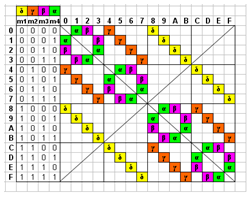Guest blog post by David Enríquez Arriano. For more information or to get higher pictures resolution, contact the author (see contact information at the bottom of this article.)
Introduction
This is a different approach to solve the AI problem. It is a cognitive math based on pyramids built with self-programming logic gates through learning.
A Boolean polynomial associated with a given truth table can be implemented with electronic logic gates. These circuits have pyramidal structures. Then I built pyramids accomplishing the generic form for any of these problems.
Although I can choose the balance between pure logic and pure memory in which they operate, in general, always I prefer to use the maximum cognitive power mathematically possible.
The result is an algorithmic that makes you feel as teacher in front of another human infinitely intelligent who learns looking for the logic that might exist in the patterns (input, output) fed in training.
This cognitive math allows continuous learning, immediate adaptation to new tasks and focus on target concepts. It also allows us to choose the degree of plasticity, also to implement control and supervision systems, although all of this it is fully self-regulated and self-scalable automatically if we desire so.
It is an absolutely simple and fundamental algorithm. This algorithmic extends the forties foundations of modern computing to its maximum possible.
At this level of pyramids everything is more crystallographic or mineral than biological. I use several of these pyramids and a few more pieces to build an artificial neuron. But the power of these pyramids is so great that for now I have not needed to build neurons and much less networks of them, although I know perfectly how to do it, why and for what it would be appropriate to take that step.
Read the full article, here.

